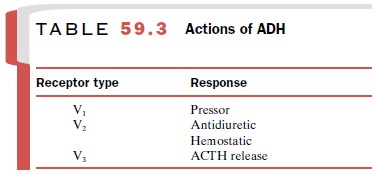Chapter: Modern Pharmacology with Clinical Applications: Hypothalamic and Pituitary Gland Hormones
Hormones of the Posterior Pituitary Gland
HORMONES OF THE
POSTERIOR PITUITARY GLAND
Antidiuretic hormone (ADH)
and oxytocin are synthe-sized in the supraoptic and paraventricular nuclei in
the brain and are transported in secretory granules through axons to the
posterior lobe. These hormones are cyclic peptides of eight amino acids. Each
is synthesized as a larger precursor, which is processed into the hormone plus
a protein that binds the hormone, called neuro-physin. ADH and oxytocin have
different amino acids at positions 3 and 8.
Antidiuretic Hormone
ADH (vasopressin) is released
primarily in response to increases in plasma osmolarity or decreases in blood
volume. It produces its antidiuretic activity in the kid-ney, causing the
cortical and medullary parts of the col-lecting duct to become more permeable
to water, thereby increasing water reabsorption, reducing serum osmolarity, and
increasing its volume. It produces this effect by binding to a subset of
vasopressin receptors (Table 59.3) called V2 that have relatively
high affinity for the hormone. ADH also has actions at sites other than the
kidney. V2 receptors also mediate an increase in circulating levels
of two proteins involved in blood coagulation: factor VIII and von Willebrand’s
factor. At higher concentrations, ADH interacts with V1 receptors to
cause a general constriction of most blood vessels. It also interacts with V3
(or V1b) receptors to increase ACTH release, although the major
control of ACTH re-lease occurs through corticotropin-releasing hormone.

ADH itself is available for
injections (Pitressin) but has a
half-life of about 15 minutes. Desmopressin (DDAVP) is an analogue without an amino group at the first amino
acid and with D-arginine instead of L-arginine. This analogue is more stable and has
very little pressor activity. Desmopressin can be given subcuta-neously or
nasally, and the effects last for 12 hours.
Because it is stable,
desmopressin is preferred for treatments especially if pressor effects are not
desired. The primary indication for therapy is central diabetes insipidus, a
disorder that results when ADH secretion is reduced and that is characterized
by polydipsia, polyuria, and dehydration. Desmopressin is also used to reduce
primary nocturnal enuresis, or bedwetting, in children. It is useful in people
with mild hemophilia A or with some types of von Willebrand’s disease, in which
von Willebrand’s factor is present at low levels. In these cases, desmopressin
is given when excessive bleeding occurs or before surgery to help reduce
bleeding indi-rectly by increasing the amounts of coagulation factors.
A possible adverse effect of
desmopressin is water in-toxication if too much is taken.
ADH antagonists, including
nonpeptide analogues that may be taken orally, have been developed with
specificity for each of the receptor types. In the future, those that block V1
receptors may be useful in treating hypertension, and those that block V2
receptors may be useful in any condition of excessive water retention or
hyponatremia, for which so far there is no satisfactory therapeutic treatment.
Oxytocin
Oxytocin (Pitocin, Syntocinon) causes milk release
(let-down) by stimulating contraction of the myoepithelial cells of the milk
ducts in lactating mammary glands; this forces milk from the alveoli of the
breast. Oxytocin re-lease is stimulated by suckling and by auditory and vi-sual
stimuli, such as a baby’s cry. Oxytocin is available as a nasal spray, which is
used as an aid to lactation when milk ejection is impaired.
Oxytocin also stimulates
contraction of uterine smooth muscle in late phases of pregnancy.
Related Topics